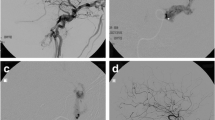Summary
Indications for the occlusion of the extradural portions of the carotid and vertebral arteries with the Fogarty catheter are demonstrated in 5 cases of traumatic carotid-cavernous sinus fistulas, in1 case of an extradural carotid aneurysm originating from the anterior portion of the carotid siphon, in1 case of traumatic carotid-jugular vein fistula and vertebral artery aneurysm with a-v shunt at the level of the atlas, and in2 cases of large tumours of the base of the skull extending into the cavernous sinus. The limitation of the method is shown in one case where the catheter could not be passed through a “high” kink of the carotid artery. “Low” kinking, at the typical site above the bifurcation, can be overcome by mobilization and stretching of the vessel while introducing the catheter.
Similar content being viewed by others
References
Bentson, J. R., and P. H. Crandall, Use of the Fogarty catheter in arteriovenous malformations of the spinal cord. Radiology105 (1972), 65–68.
Leape, L. L., and E. Palacios, Acute traumatic vertebral arteriovenous fistulas. Ann. Surg.174 (1971), 908–910.
Lepoire, J., Personal contribution at the Joint Meeting of the French and German Neurosurgical Societies, Agadir, March 14–21, 1974.
Obrador, S., J. Bueno Gomez, E. Roda, and M. Soto, Fistulas carotid-cavernosas. Rev. Esp. Oto-Neuro-Ophthalmol. Neurocir.182 (1973), 197–218.
Ohta, T., S. Nishimura, H. Kikuchi, and M. Toyama, Closure of carotid-cavernous fistulas with polyurethane from embolus. J. Neurosurg.38 (1973), 107–112.
Parkinson, D., Carotid cavernous fistula: direct repair with preservation of the carotid artery. J. Neurosurg.38 (1973), 99–106.
Prolo, D., and J. W. Hanberg, Intraluminal occlusion of a carotid cavernous sinus fistula with a balloon catheter: a technical note. J. Neurosurg.35 (1971), 237–242.
Rey, A., J. Cophignon, R. Djindjian, and R. Houdart, Traitement de fistules carotido-caverneuses. Neuro-Chirurgie19 (1973), 111–122.
Rothman, S. L., A. G. Pratt, E. L. Kier, and W. E. Allen, Traumatic vertebral-carotid-jugular arteriovenous aneurysm. J. Neurosurg.41 (1974), 92–99.
Rougerie, J., D. Guilmet, and C. Bamberger-Bozo, Anévrysme carotido-caverneux. A propos d'une orientation thérapeutique nouvelle. Neuro-Chirurgie19 (1973), 649–654.
Serbinenko, F. A., Balloon occlusion of a cavernous portion of the carotid artery as a method of treating carotid cavitary anastomoses. Problems of Neurosurg.6 (1971), 3–8.
—, Balloon catheterization and occlusion of major cerebral vessels. J. Neurosurg.41 (1974), 125–145.
Author information
Authors and Affiliations
Rights and permissions
About this article
Cite this article
Herrmann, H.D., Fischer, D. & Loew, F. Experiences with intraluminal occlusion with the Fogarty catheter in the treatment of carotid-cavernous sinus fistulas and other lesions at the base of the skull. Acta neurochir 32, 35–54 (1975). https://doi.org/10.1007/BF01405901
Issue Date:
DOI: https://doi.org/10.1007/BF01405901




